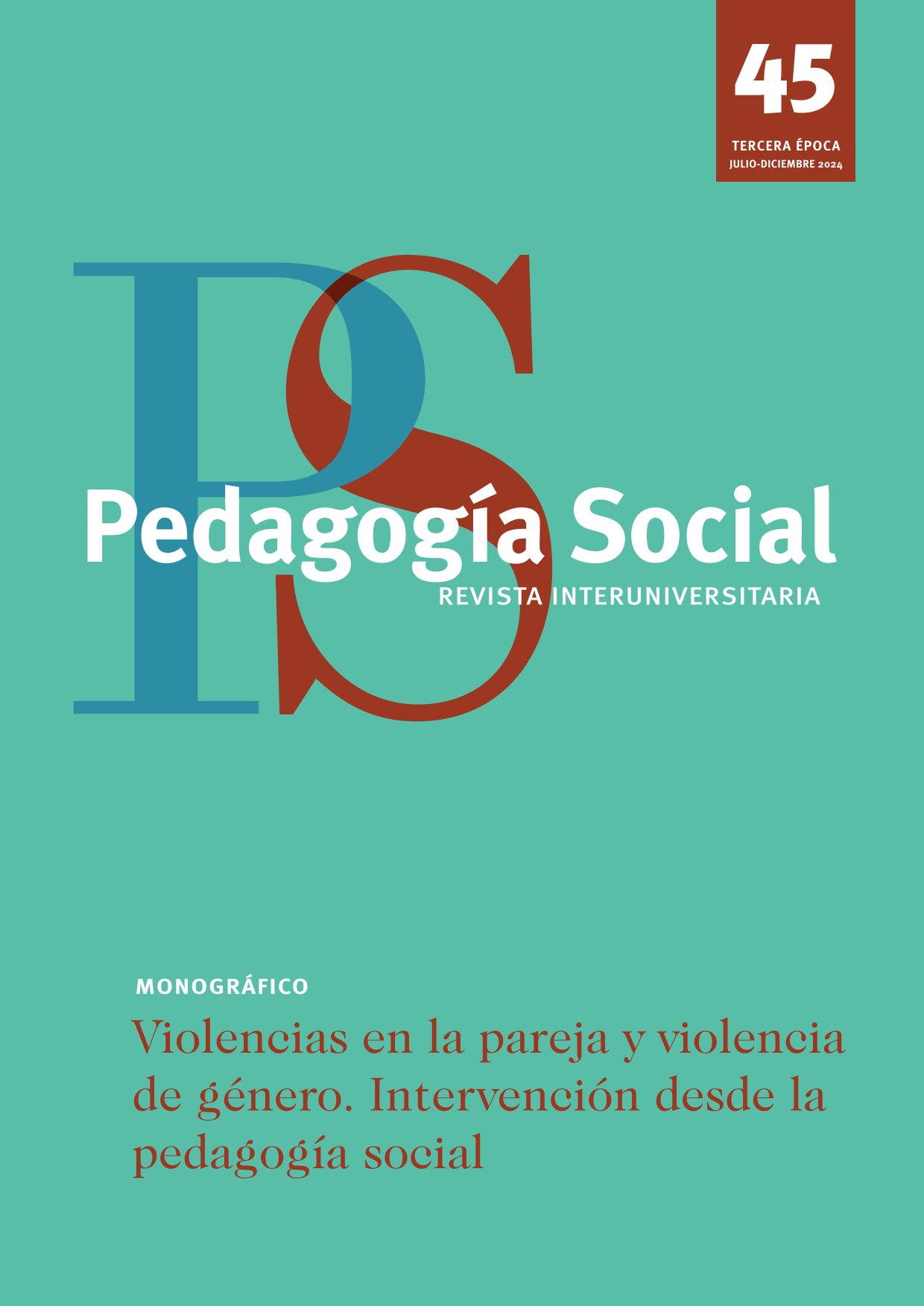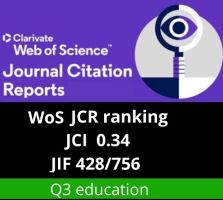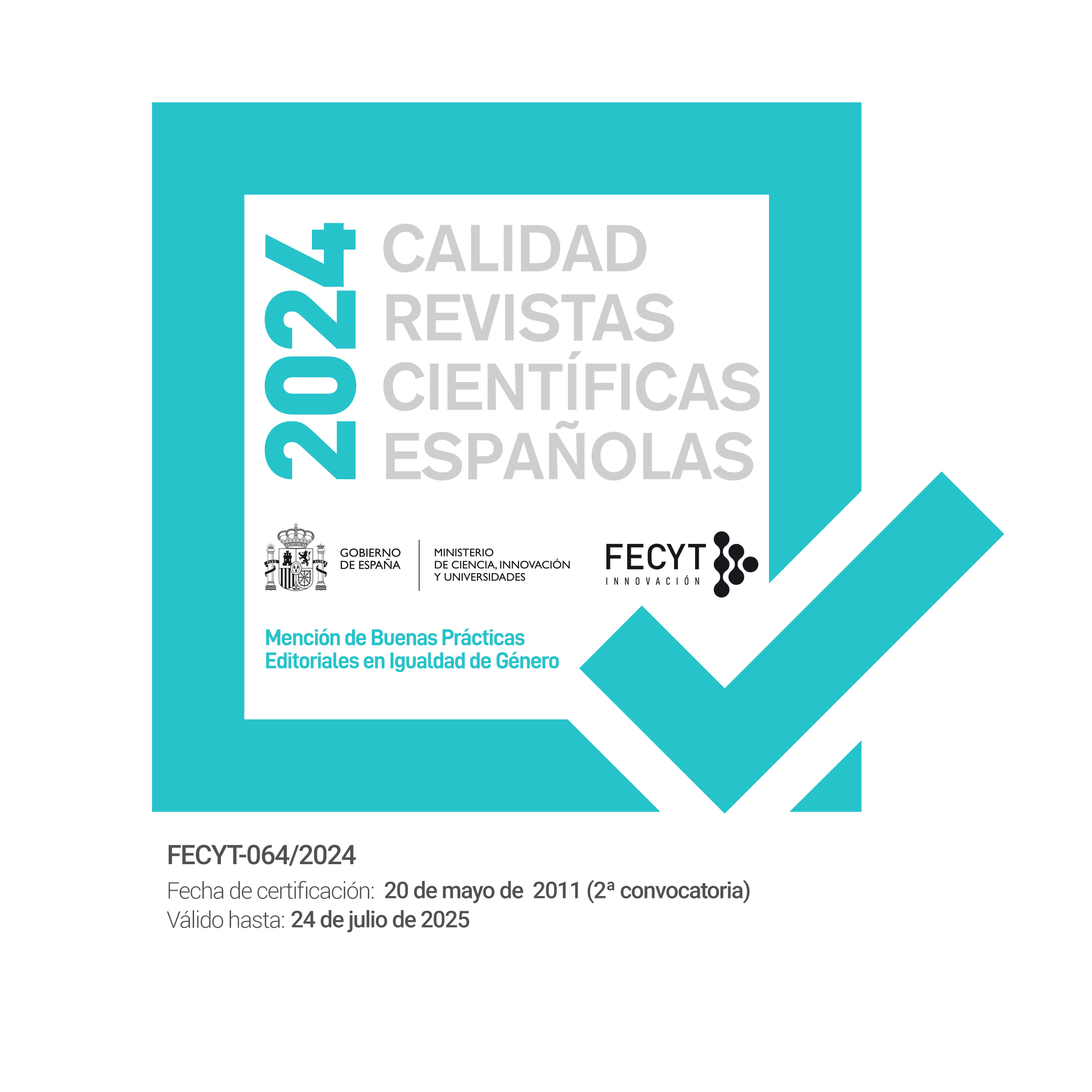Adolescents facing violence and the myths of love in dating relationships
DOI:
https://doi.org/10.7179/PSRI_2024.45.05Keywords:
Violence, love myths, interpersonal relationships, adolescenceAbstract
This study aims to analyse the prevalence of dating violence and love myths among adolescents in the province of Granada (Spain). For this purpose, a descriptive, non-experimental, quantitative research design was used. The sample consisted of 802 participants. The data collection instrument used was the VIRADO questionnaire from the adaptation of the VIREPA questionnaire by González-Gijón and Soriano (2021) and the Romantic Love Myths Scale (SMRL) by Bonilla-Algovia and Rivas-Rivero (2020). The results showed that the most frequent form of violence in dating relationships among young adolescents is emotional violence, followed by physical and psychological violence, and social and economic control. The type of violence least experienced by the participants in this study was personal devaluation and sexual abuse. Furthermore, analysing the scale of love myths, the highest mean values corresponded to idealised love and romantic love, followed by distorted love, with significant differences in relation to sex.
Downloads
References
Alarcón-Vásquez, Y., De la Cruz, L., Arrieta-Fernández, L., Figueroa-Chico, D., López-Bosso, C. y Llanos. J. (2022). Factores asociados a la violencia de pareja en jóvenes universitarios. Tejidos Sociales, 1(4), 1-14.
Alegría, M. y Rodríguez, A. (2015). Violencia en el noviazgo: Perpetración, victimización y violencia mutua. Una revisión. Actualidades en Psicología, 29(118), 57-72.
Álvarez, P. R., Díaz, A. S., Martínez-Heredia, N. y González-Gijón, G. (2024). La producción científica sobre la violencia en las relaciones de pareja de adolescentes en España. Un análisis bibliométrico. iQual. Revista de Género e Igualdad, (7), 120-135.
Bonilla-Algovia, E., Rivas-Rivero, E. y Gómez, I. P. (2021). Mitos del amor romántico en adolescentes: relación con el sexismo y variables procedentes de la socialización. Educación XX1, 24(2), 441-463.
Bonilla-Algovia, E. y Rivas-Rivero, E. (2018). Mitos del amor romántico en una muestra de futuros y futuras docentes. Revista de Estudios e Investigación en Psicología y Educación, 5(2), 113-117. https://doi.org/10.17979/reipe.2018.5.2.3624
Bonilla-Algovia, E. y Rivas-Rivero, E. (2020). Diseño y validación de la Escala de Mitos del Amor Romántico. Revista Iberoamericana de Diagnóstico y Evaluación-e Avaliação Psicológica, 4(57), 119-136.
Buendía, L. y Berrocal, E. (2001). La ética de la investigación educativa. Agora digital, 1(9), 1-14.
Cava, M-J., Tomás, I., Buelga, S. y Carrascosa, L. (2020). Loneliness, depressive mood and cyberbullying victimization in adolescent victims of cyber dating violence. International Journal of Environmental Research and Public Health, 17(12), 4269. https://doi.org/10.3390/ijerph17124269
Cerezo, F. (2009). La violencia en las aulas. Análisis y propuestas de intervención. Pirámide.
Cornelius, T. L. y Resseguie, N. (2007). Primary and secondary prevention programs for dating violence: A review of the literature. Aggression and Violent Behavior, 12(3), 364–375. https://doi.org/10.1016/j.avb.2006.09.006
Dalouh, R. y Ayala, E. S. (2020). La educación en valores como prevención de la violencia en parejas adolescentes en entornos transculturales. Publicaciones, 50(1), 61-81.
Diaz-Aguado, M. J. (2005). Diez condiciones básicas para prevenir la violencia desde la adolescencia. Estudios de Juventud, 62.
Díaz-Aguado, M. y Carvajal, M. (2011). Equality and the prevention of gender-based violence in adolescence. Publicaciones Ministerio de Sanidad, Política Social e Igualdad.
Díaz-Aguado, M.J. y Carvajal, M.I. (2011). Igualdad y prevención de la violencia de género en la adolescencia y la Juventud. Ministerio de Sanidad, Igualdad y Servicios Sociales.
Díaz-Aguado, M.J. y Martínez-Arias, R. (2022). Types of Male Adolescent Violence Against Women in Three Contexts: Dating Violence Offline, Dating Violence Online, and Sexual Harassment Online Outside a Relationship. Frontiers in Psychology 13, 50897. https://doi.org/10.3389/fpsyg.2022.850897
Donoso, T., Rubio, M.J. y Baños, R. (2018). La adolescencia ante la violencia de género 2.0: Concepciones, conductas y experiencias. Educación XXI, 21(1), 109-134. https://doi.org/10.5944/educXX1.20180
Elmquist, J., Wolford-Clevenger, C., Zapor, H., Febres, J., Shorey, R. C., Hamel, J. y Stuart, G. L. (2016). A gender comparison of motivations for physical dating violence among college students. Journal of Interpersonal Violence, 31(1). https://doi.org/10.1177/0886260514555130
Espelage, D.L. y Holt, M.K. (2007). Dating violence & sexual harassment across the bully-victim continuum among middle and high school students. Journal of Youth Adolescence, 36, 799-811.
Estévez, E., y Jiménez, T. (2015). Aggressive behaviour and personal and school adjustment in a sample of Spanish adolescent students. Universithas Psychologica, 14, 111–123. http://dx.doi.org/10.11144/Javeriana.upsy14-1.caap
Estevez-Casellas, C., Gómez-Medina, M. D. y Sitges, E. (2021). Relationship between emotional intelligence and violence exerted, received and perceived in teen dating relationships. Relationships. International Journal Environmental Research and Public Health, 18, 3-15. https://doi.org/10.3390/ijerph18052284
Flores, N. P. y Palencia, E. M. (2023). Violencia en las relaciones de noviazgo entre adolescentes de 13 a 19 años; bajo el enfoque del cuidado humano. Prohominum. Revista de Ciencias Sociales y Humanas, 5(4), 25-35.
Frías-Navarro, D. (2022). Apuntes de estimación de la fiabilidad de consistencia interna de los ítems de un instrumento de medida. Universidad de Valencia, 23.
Gallego Montes, G., Alzate, V. y Fernando, J. (2023). Noviazgos violentos: amor, emparejamiento e imaginarios de género en jóvenes escolarizados. Universidad de Caldas.
Gámez-Guadix, M. y Mateos-Pérez, E. (2019). Longitudinal and reciprocal relationships between sexting, online sexual solicitations, and cyberbullying among minors. Computers in Human Behavior, 94, 70–76. https://doi.org/10.1016/j.chb.2019.01.004.
Garrido-Antón, M. J., Arribas-Rey, A., de Miguel, J. M. y García-Collantes, Á. (2020). La violencia en las relaciones de pareja de jóvenes: prevalencia, victimización, perpetración y bidireccionalidad. Revista Logos Ciencia & Tecnología, 12(2), 8-19.
González R. y Santana, J. (2001). Violencia en parejas jóvenes. Análisis y prevención. Pirámide.
González-Gijón, G. y Soriano-Díaz, A. (2021). Análisis psicométrico de una escala para la detección de la violencia en las relaciones de pareja en jóvenes. RELIEVE. Revista Electrónica de Investigación y Evaluación Educativa, 27(1).
González-Ortega, I., Echeburúa, E. y de Corral, P. (2008). Variables significativas en las relaciones violentas en parejas jóvenes: una revisión. Psicología Conductual, 16, 207-225.
Guillén Verdesoto, X., Ochoa Balarezo, J., Delucchi, G., León Mayer, E. y Folino, J. (2021). Celos y violencia en parejas de estudiantes de la Universidad de Cuenca, Ecuador. Ciencias Psicológicas, 15(1), e-2353. https://doi.org/10.22235/cp.v15i1.2353
Hernando, Á. (2007). La prevención de la violencia de género en adolescentes. Una experiencia en el ámbito educativo. Apuntes de Psicología, 26, 325-340.
Jiménez, T. y Estévez, E. (2017). School aggression in adolescence: Examining the role of individual, family and school variables. International Journal of Clinical and Health Psychology, 17, 251–260. https://doi.org/10.1016/j.ijchp.2017.07.002
Lucariello, E. y Fajardo, M. I. (2011). Prevención de la violencia de género en los adolescentes. International Journal of Developmental and Educational Psychology, 1(5), 113-121.
Luizaga, M. R. T. (2023). Las representaciones sociales: Un marco teórico y metodológico para abordar la problemática social de la violencia en las relaciones de noviazgo. Warisata-Revista de Educación, 5(13), 89-103.
Manchikanti, A. (2011). Testing the cycle of violence hypothesis: Child abuse and adolescent dating violence as predictors of partner violence in young adulthood. Youth & Society, 43, 171–192. https://doi.org/10.1177/0044118X09358313.
Martínez, V. M., Gancedo, Y., Castro, B. y Berodia, A. S. (2020). Victimización de violencia entre novios, gravedad percibida en las conductas de violencia entre novios, mitos del amor romántico, y dependencia emocional entre chicos y chicas adolescentes. Revista iberoamericana de psicología y salud, 11(2), 132-145.
Méndez, R. L. R. (2023). Violencia basada en género en relaciones de pareja adolescentes: una revisión integral. Revista Ciencias Humanas, 16, 17-30.
Luken, V. M. (2015). Perception of gender-based violence among adolescents and young adults. Government Delegation for Gender-Based Violence (MSSSI) publications.
Molla-Esparza, C., López-González, E. y Losilla, J.-M. (2021). Sexting prevalence and Socio-demographic correlates in Spanish secondary school students. Sexuality Research & Social Policy: Journal of NSRC: SR & SP, 18(1), 97–111. https://doi.org/10.1007/s13178-020-00434-0.
Morelli, M., Bianchi, D., Baiocco, R., Pezzuti, L. y Chirumbolo, A. (2016). Sexting, psychological distress and dating violence among adolescents and young adults. Psicothema, 28(2), 137–142. https://doi.org/10.7334/psicothema2015.193.
Muñoz-Rivas, M. J., Graña Gómez, J. L., O’Leary, K. D. y González Lozano, P. (2007). Physical and psychological aggression in dating relationships in Spanish university students. Psicothema, 19(1), 102–107.
Perea, L. G. y Almanzor, C. V. (2020). Mitos del amor romántico y calidad en las relaciones sentimentales adolescentes. Revista Iberoamericana de Psicología: Ciencia y Tecnología, 13(1), 150-161.
Rey, C. (2008). Prevalencia, factores de riesgo y problemáticas asociadas con la violencia en el noviazgo: una revisión de la literatura. Avances en Psicología Latinoamericana, 26, 227-241.
Rivas-Rivero, E. y Bonilla-Algovia, E. (2021). Relación entre los mitos románticos y las actitudes hacia la igualdad de género en la adolescencia. Psychology, Society & Education, 13(3), 67-80.
Rodríguez, S. (2015). Dating violence: Preliminary study of prevalence and justification. Pedagogía social: Revista interuniversitaria, 25, 251–275.
Romero-Méndez, C., Rojas-Solís, J. y Greathouse, L. (2021). Co-ocurrencia de distintos tipos de violencia interpersonal en adolescentes mexicanos. Pedagogía Social. Revista Interuniversitaria, 38. https://doi.org/10.7179/PSRI_2021.38.09
Ruiz-Narezo, M., Santibañez, R. y Laespada, T. (2021) Antisocial and Criminal Behaviour, School Violence, and Dating Violence in Adolescence. Pedagogía Social. Revista Interuniversitaria, 39, 139-152. https://doi.org/10.7179/PSRI_2021.39.09
Sanpedro, P. (2005). El mito del amor y sus consecuencias en los vínculos de pareja. Página Abierta.
Straus, M.A. y Ramírez, I.L. (2003). International dating violence study. Family Research Laboratory. International Journal of Clinical and Health Psychology, 6(2), 271–284.
Valenzuela-Varela, A. y Vega-López, M. G. (2015). Violencia en el noviazgo en adolescentes. Un problema de salud pública. Salud Jalisco, 2(3), 164-168.
Vives-Cases, C., Pérez-Martínez, V., Davó-Blanes, M., SanSegundo, M. S., Gil González, D., Abiétar, D. G., Sánchez-Martínez, F., Forcadell-Díez, L. y Pérez, G. (2021). Dating violence and associated factors among male and female adolescents in Spain. Research Square. https://doi.org/10.21203/rs.3.rs-337188/v1.
Vizcarra, M. B., Poo, A. M., y Donoso, T. (2013). Programa educativo para la prevención de la violencia en el noviazgo. Revista de Psicología, 22(1), 24-61.
Wincentak, K., Connolly, J., y Card, N. (2017). Teen dating violence: A meta-analytic review of prevalence rates. Psychology of Violence, 7(2), 224-241. https://doi.org/10.1037/a0040194
Published
How to Cite
Issue
Section
License

This work is licensed under a Creative Commons Attribution-NonCommercial-ShareAlike 4.0 International License.
Copyright and right to archive
The published version of the articles can be self-archived by their authors in open access institutional and thematic repositories. However, Pedagogía Social. Revista Interuniversitaria must authorize partial or global reutilisation on new papers or publications.
Published papers must be cited including the title of the journal Pedagogía Social. Revista Interuniversitaria, issue, pages and year of publication
Ethical responsibilities
Pedagogía Social. Revista Interuniversitaria does not accept any material that has been previously published in other documents or publications. Authors are responsible for obtaining the required permissions for partial or global reproduction any material from other publications, and to correctly quote its origin.
Pedagogía Social. Revista Interuniversitaria is obliged to detect and report fraudulent practices.
Only those who have intellectually contribute to the development of the paper must appear as authors.
The journal expects authors to declare any commercial partnership that might entail a conflict of interest with respect to the submitted article.
Authors must mention in the article, preferably in the “methodology” section, that the procedures used during the samplings and controls have been made after getting informed consent.
The journal will not use any received contribution in a way other than the goals described in these guidelines.
Copyright Notice
© Pedagogía Social. Revista Interuniversitaria. Papers published in both the printed and online versions of this Journal are property of Pedagogia Social. Revista Interuniversitaria, being required to cite the source in any partial or total reproduction.
Unless otherwise stated, all content of this electronic journal is distributed under "Creative Commons Attribution-Non commercial 3.0 Spain" (CC-by-nc) license for use and distribution. The informative version and the legal text of this license is available here. This has to be expressly stated in this way when necessary.






